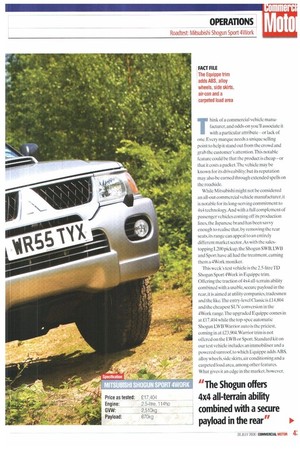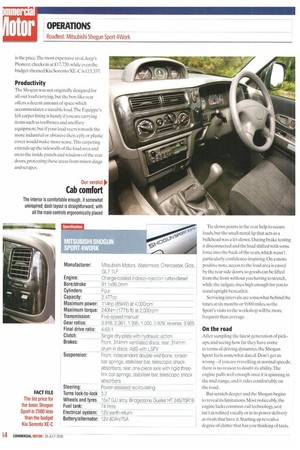FACT FILE The Equippe trim adds ABS, alloy wheels. side
Page 43

Page 44

Page 45

Page 46

If you've noticed an error in this article please click here to report it so we can fix it.
skirts, air-con and a carpeted load area Think of a commercial vehicle mannfacturer,and odds-on you'll associate it with a particular attribute -or lack of one. Every marque needs a unique selling point to help it stand out from the crowd and grab the customer's attention.This notable feature could be that the product is cheap -or that it costs a packet.The vehicle may be known for its driveability; but its reputation may also be earned through extended spells on the roadside.
While Mitsubishi might not be considered an all-out commercial vehicle manufacturer, it is notable for its long-serving commitment to 4x4 technology.And with a full complement of passenger vehicles coming off its production lines, the Japanese brand has been savvy enough to realise that, by removing the rear seats, its range can appeal to an entirely different market sector. As with the salestopping L200 pickup, the Shogun SWB, LWB and Sport have all had the treatment, earning them a 4Work moniker.
This week's test vehicle is the 2.5-litre 'I'D Shogun Sport 4Work in Equippe trim. Offering the traction of 4x4 all-terrain ability combined with a usable, secure payload in the rear, it is aimed at utility companies, tradesmen and the like.The entry-level Classic is £14,804 and the cheapest SUV conversion in the 4Work range. The upgraded Equippe comes in at £17,404 while the top-spec automatic Shogun LWB Warrior auto is the priciest, coming in at f23,904.Warrior trim is not offered on the LWB or Sport. Standard kit on our test vehicle includes an immobiliser and a powered sunroof, to which Equippe adds ABS, alloy wheels, side skirts, air conditioning and a carpeted load area, among other features. What gives it an edge in the 111 a rk et , however, is the price:The most expensive rival. Jeep's Pioneer.checks in at £17,720, while even the budget-theined Kia Sorento XE-C is £15,337.
Productivity The Shogun was not originally designed for all-out load carrying, but the box-like rear offers a decent amount of space which accommodates a sizeable load.The Equippe's felt carpet lining is handy if you are carrying items such as toolboxes and ancillary equipment, but if your load veers towards the more industrial or abrasive then a ply or plastic cover would make more sense.This carpeting extends up the sidewalls of the load area and on to the inside panels and windows of the rear doors, protecting these areas from minor dings and scrapes. Tie-down points in the rear help to secure I oads,but the small metal lip that acts as a bulkhead was a let-down. During brake testing it disconnected and the load shifted with some force into the back of the seats, which wasn't particularly confidence-inspiring. On a more positive note, access to the load area is eased by the rear side doors, so goods can be lifted from the front without you having to stretch, while the tailgate rises high enough for you to stand upright beneath it.
Servicing intervals are somewhat behind the times at six months or 9.0(X) miles, so the Sport's visits to the workshop will be more frequent than average.
On the road
After sampling the latest generation of pickups, and seeing how far they have come in terms of driving dynamics, the Shogun Sport feels somewhat dated. Don't get us wrong — if you are travelling at normal speeds, there is no reason to doubt its ability.The engine pulls well enough once it is spinning in the mid-range, and it rides comfortably on the road.
But scratch deeper and the Shogun begins to reveal its limitations Most noticeably, the engine lacks common-rail tech nology.so it isn't as refined vocally or in us power delivery as rivals that have it. Starting up reveals a degree of clatter that has you thinking of taxis, while the driveline snatches noticeably on take-up and between gear changes.
Pushing on through corners, the Mitsubishi struggles to maintain the pace. with tyres screeching to display their dissatisfaction. During brake testing, the pedal needed plenty of foot pressure (especially when fully loaded) to get us stopping in time.
Conversely. however.
Mitsubishi is all about off-road and that's where the Shogun shows its mettle. In the dirt, its ability is greater than the sum of its parts.There is plenty of compliance in the suspension. absorbing rough terrain, while climbing and dropping arc handled competently as long as you work the engine.
Cab comfort
In Equippe spec, the Shogun offers a comfortable if somewhat uninspired interior.The dash layout is straightforward enough with all the main controls ergonomically placed.The central console, which houses the secondary functions, comes complete with a shiny, black plastic covering that contrasts the light and dark greys elsewhere in the cabin. Storage comprises slim door bins,several small cubbies and twin cup-holders between the seats.
The build seems solid, though the engine noise does intrude somewhat especially under acceleration. At lower speeds, the cabin is a reasonably comfortable place to be, with the suspension absorbing bumps and undulations adequately.
Forward visibility is good, allowing you to position the front of the vehicle accurately (which is particularly beneficial off-road), while the clear rear window enables you to reverse without wondering what is behind. •
























































































































































































